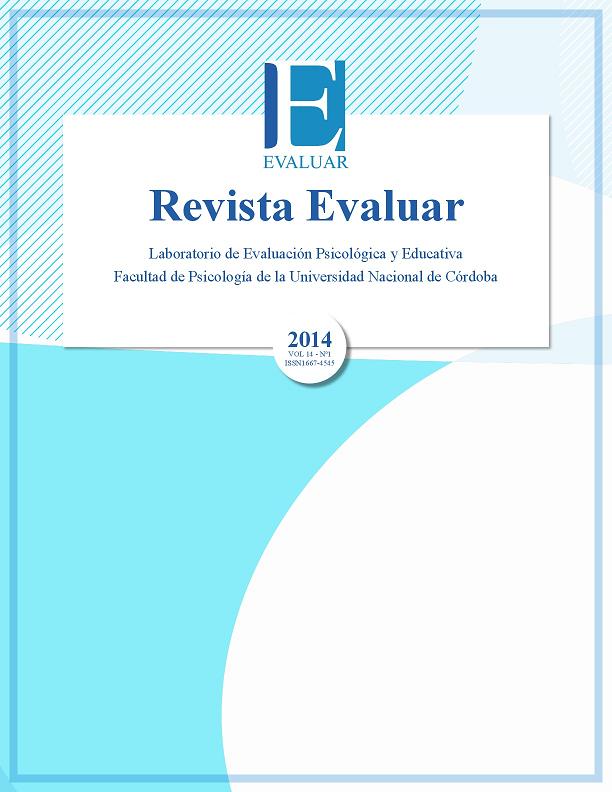Psychometric properties of the emotional quotient inventory in its version for adolescents (EQ-i-YV)
DOI:
https://doi.org/10.35670/1667-4545.v14.n1.8409Abstract
This study has the purpose of analyzingthe psychometric properties of the emotional quotient inventory in its version for adolescents (EQ-i-YV). The instrument was applied to a sample of 839 Mexican adolescents between ages 12 and 16. Results show a similar structure to validations done in Spanish language, except for the division made to one of the factors. In the same manner, a short version of the instrument is provided, which was obtained through deleting items that were gathered separately from the theoretical model proposal, as well as through those with low factorial value that increased validity of the scale at the moment of being deleted.
Downloads
References
Bar-On, R. (1997).The emotional quotient inventory (EQ-i): A test of emotional intelligence. Toronto: Multi-Health Systems.
Bar-On, R. (2000). Emotional and social intelligence: Insights from the emotional quotient inventory. In R. Bar-On y J. D. A. Parker (Eds.), The Handbook of Emotional Intelligence (pp. 363–388). San Francisco: Jossey-Bass.
Bar-On, R. (2006). The Bar-On model of emotional-social intelligence (ESI). Psicothema, 18 (Supl,), 13-25.
Bar-On, R., & Parker, J. (2000). EQ-i: YV Bar On Emotional Quotient Inventory: Youth version. Technical Manual Toronto: Multi Health Systems Inc.
El Hassan, K., & El Sader, M. (2005). Arabizing and validating the Bar-On EQ-I:YV in Lebanese context. International Journal of Testing, 5, 301-317.
Extremera N., & Fernández-Berrocal, P. (2007). Una guía práctica de los instrumentos actuales de evaluación de la inteligencia emocional. En J. M. Mestre y Fernández-Berrocal, P. (Coords), Manual de Inteligencia Emocional (pp. 99-122). Madrid: Psicología Pirámide.
Ferrándiz, C., Hernández, D., Bermejo, R., Ferrando, M., & Sáinz, M. (2012). Social and emotional intelligence in childhood and adolescence: Spanish validation of a measurement instrument. Revista Psicodidáctica, 17, 309-338. doi: 10.1387/RevPsicodidact.2814
López-Zafra, E., Pulido, M., & Berrios, P. (2014). EQ-i Versión corta (EQI-C), Adaptación y validación al español del EQ-i en universitarios. Boletín de Psicología, 110, 21-36.
Mayer, J. D., DiPaolo, M., & Salovey, P. (1990). Perceiving affective content in ambiguous visual stimuli: A component of emotional intelligence. Journal of Personality Assessment, 54,772-781.
Mayer, J. D., Salovey, P., & Caruso, D. (2008). Emotional Intelligence, New Ability or Eclectic Traits. American Psychologist, 63(6), 503-517. doi: 10.1037/0003-066X.63.6.503
Parker, J., Saklofske, D., Shaughnessy, P., Huang, S., Wood, L., & Eastabrook, J. (2005). Generalizability of the emotional intelligence construct: A cross-cultural study of North American aboriginal youth. Personality and Individual Differences, 39, 215-227. doi: 10.1016/j.paid.2005.01.008
Sainz, M., Ferrándiz, C., Fernández, C., & Ferrando, M. (2014). Propiedades psicométricas del Inventario de Cociente Emocional EQ-i: YV en alumnos superdotados y talentosos. Revista de Investigación Educativa, 32, 41-55. http://dx.doi.org/10.6018/rie.32.1.162501
Salovey, P., & Mayer, D. (1990). Emotional intelligence. Imagination, Cognitionand Personality, 9, 185-211.
Tannous, A., & Matar, J. (2010). The relationship between depression and emotional intelligence among a sample of Jordanian children. Procedia Social and Behavioral Sciences, 5, 1017-1022. doi: 10.1016/j.sbspro.2010.07.228
Ugarriza, N. (2001). La evaluación de la inteligencia emocional a través del inventario de Bar-On (I-CE) en una muestra de Lima metropolitana. Persona, 4, 129-160.
Ugarriza, N., & Pajarés, L. (2005). La evaluación de la inteligencia emocional a través del inventario de Bar-On ICE: NA, en una muestra de niños y adolescentes. Persona, 8, 11-58.
Downloads
Published
Issue
Section
License
Copyright (c) 2014 Norma Alicia Ruvalcaba Romero, Julia Gallegos Guajardo, Maryurena Lorenzo Alegría, África Borges del Rosal

This work is licensed under a Creative Commons Attribution 4.0 International License.
Revista Evaluar aplica la Licencia Internacional de Atribuciones Comunes Creativas (Creative Commons Attribution License, CCAL). Bajo esta licencia, los autores retienen la propiedad de copyright de los artículos pero permiten que, sin que medie permiso de autor o editor, cualquier persona descargue y distribuya los artículos publicados en Evaluar. La única condición es que siempre y en todos los casos se cite a los autores y a la fuente original de publicación (i.e. Evaluar). El envío de artículos a Evaluar y la lectura de los mismos es totalmente gratuito.



